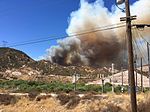Cajon Junction
San Gabriel MountainsUnincorporated communities in CaliforniaUnincorporated communities in San Bernardino County, CaliforniaUse mdy dates from July 2023
Cajon Junction is an unincorporated community in Cajon Canyon and the northern Cajon Pass area, within San Bernardino County, California. It is located at the intersection of California State Route 138 (Pearblossom Highway) and Interstate 15 It lies at an elevation of 3,113 feet (949 meters), above the southern Victor Valley in the northeastern San Gabriel Mountains foothills. And is north of Keenbrook, Cozy Dell and Icenbrook Cajon Junction is a popular stop in the Cajon Pass there is a gas station and multiple fast food restaurants in the area.
Excerpt from the Wikipedia article Cajon Junction (License: CC BY-SA 3.0, Authors).Cajon Junction
Mojave Freeway,
Geographical coordinates (GPS) Address Nearby Places Show on map
Geographical coordinates (GPS)
| Latitude | Longitude |
|---|---|
| N 34.311666666667 ° | E -117.47472222222 ° |
Address
Mojave Freeway
Mojave Freeway
92371
California, United States
Open on Google Maps






